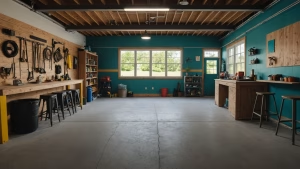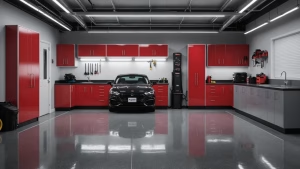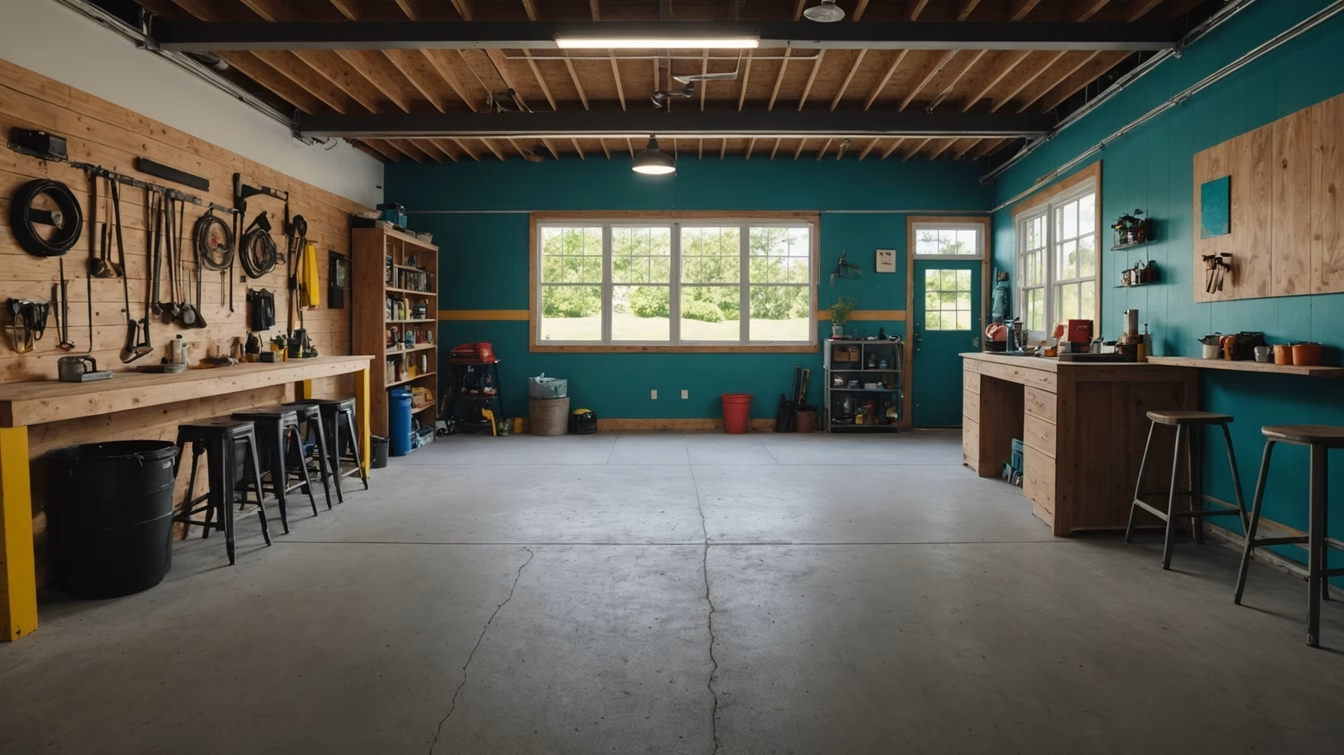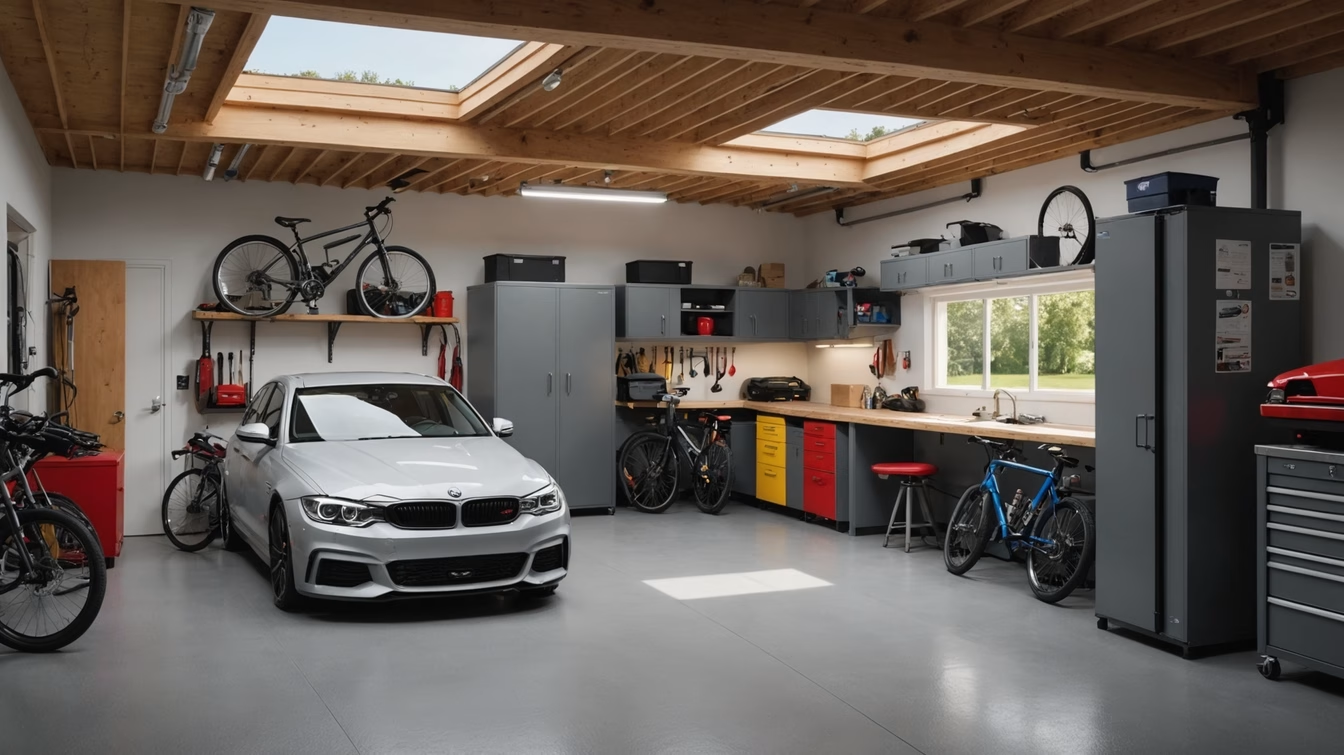Proper ventilation in your garage is essential for a healthy and functional space. Homeowners often face issues like poor air quality and high temperatures. Learning how to vent your garage effectively improves comfort and controls humidity and pollutants.
This guide provides key garage ventilation tips. It focuses on the best garage vent installation. This ensures you have the perfect system for your needs.
Understanding the Importance of Garage Ventilation
Proper ventilation in a garage is crucial for several reasons. It goes beyond just comfort. It greatly affects health, safety, and vehicle performance.
Health Benefits of Proper Ventilation
Good garage ventilation is key to maintaining air quality. Harmful fumes from vehicles and chemicals can be harmful in a poorly ventilated space. Adequate airflow reduces respiratory issues and exposure to toxic pollutants. This leads to a safer and healthier environment for frequent users.
Preventing Moisture and Mold Issues
Excess moisture causes condensation, which fosters mold growth. It’s essential to prevent mold to protect the garage and stored items. Ventilation helps control humidity, reducing mold and mildew risks. This approach keeps belongings safe and the space safe for activities.
Enhancing Vehicle Performance
Garage ventilation directly impacts vehicle performance. Excess heat can damage vehicle components, reducing efficiency. A well-ventilated garage keeps it cooler, benefiting sensitive items and vehicles. This leads to smoother, more reliable vehicle operation over time.
Key Signs Your Garage Needs Better Ventilation
Recognizing the signs of poor ventilation in your garage can prevent bigger problems later. Homeowners should watch for certain indicators that show it’s time to boost airflow. Here are some key signs your garage might need better ventilation.
Stale Air and Unpleasant Odors
The smell of stale air and musty odors often points to trapped pollutants and moisture. This situation shows there’s not enough airflow to keep the area fresh. By using garage ventilation tips, you can greatly enhance air quality and get rid of these bad smells.
Excessive Heat in Summer
Excessive heat in your garage during summer is another clear sign of poor ventilation. If your garage feels like an oven, it means hot air isn’t escaping properly. This uncomfortable situation can harm not just the space but also the items stored there.
Visible Mold or Mildew
Visible mold or mildew is a serious sign of poor ventilation. These growths love humid environments, showing that moisture isn’t being managed well. Fixing ventilation issues quickly can stop health problems and prevent damage to your garage and its contents.
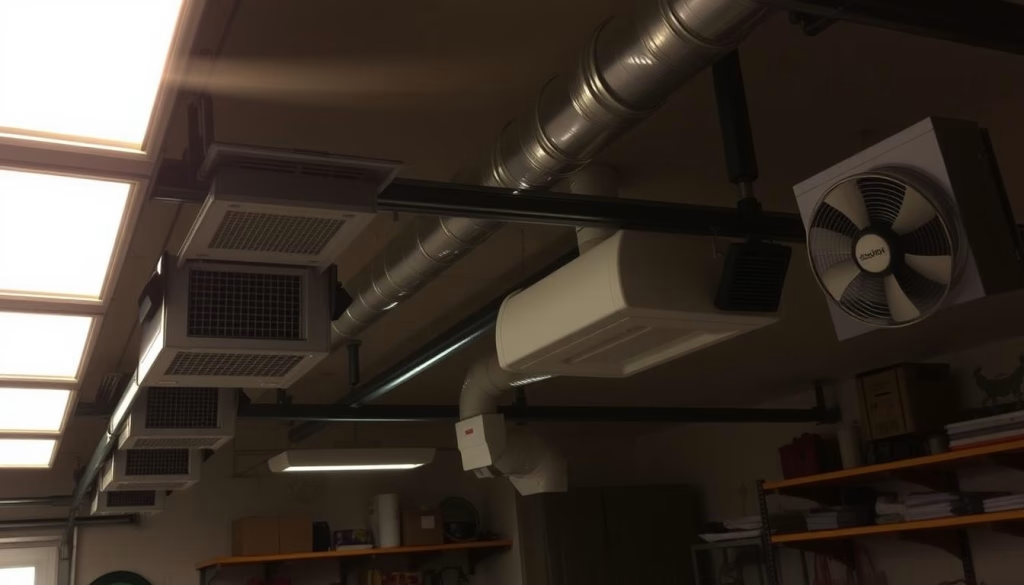
Common Garage Ventilation Methods
Improving air quality in a garage can greatly enhance the environment. There are several common garage ventilation methods, each with its own benefits. Knowing these options helps homeowners pick the best solution for their needs.
Passive Ventilation Solutions
Passive solutions offer a cost-effective way to improve airflow without mechanical systems. They include:
- Roof vents, which allow hot air to escape.
- Soffit vents that facilitate fresh air intake from lower areas.
- Window vents that can be opened to promote cross-ventilation.
These methods use natural airflow, making them energy-efficient and easy to maintain.
Active Ventilation Systems
Active systems, however, use mechanical components to manage airflow. They include:
- Exhaust fans designed to remove stale air.
- Supply fans that bring in fresh air from outdoors.
- Heat recovery ventilators that exchange stale indoor air for fresh outdoor air while conserving energy.
Active systems can significantly improve temperature control and reduce humidity, making the garage more comfortable.
Exhaust Fans and Their Benefits
Exhaust fans are particularly effective in creating a healthy garage environment. Some exhaust fan benefits include:
- Effective removal of odors and harmful fumes.
- Temperature regulation, particularly during hot weather.
- Prevention of moisture accumulation, which can lead to mold problems.
Whether you choose passive solutions or active systems, understanding the various garage ventilation methods is key to making informed decisions for better airflow.
Choosing the Right Ventilation System for Your Garage
Choosing the right ventilation system for your garage requires careful thought. Homeowners must consider space, design, budget, and climate impact. This ensures your garage has optimal air quality and safety.
Assessing Space and Design
Start by measuring your garage’s dimensions. This will help determine the airflow you need. A good system should bring in fresh air and keep stale air out. Think about your garage’s layout and any barriers, like shelves or vehicles, that could affect airflow.
Budget Considerations
Budget is key when picking a garage ventilation system. Look at the costs of different systems, including materials and installation. Options range from simple vents to active systems, which cost more upfront but offer long-term benefits.
Climate Impact
The climate where you live affects your ventilation needs. In hot areas, active systems like exhaust fans or whole-house systems work best. But in cooler climates, passive systems might be enough for good airflow.
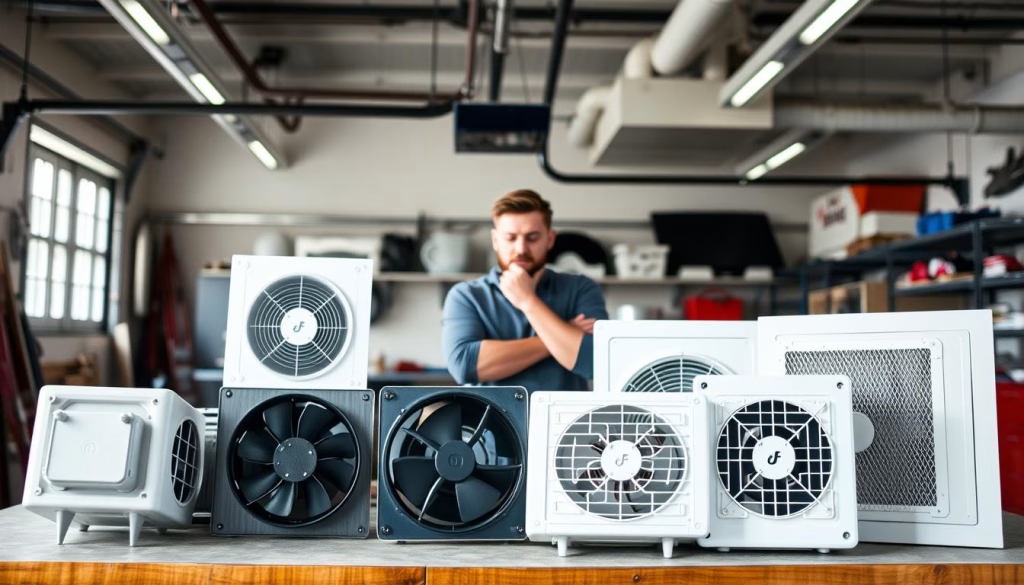
DIY Garage Ventilation Solutions
Improving your garage’s air quality is achievable with DIY methods. Homeowners can enhance ventilation by installing soffit vents, using windows for airflow, and adding roof vents. These steps not only cut down on heat and moisture but also make the environment healthier.
Installing Soffit Vents
Soffit vents are a smart choice for bringing fresh air into your garage. They work best when paired with other ventilation methods, creating a natural flow of air. Properly placed soffit vents ensure air exchange, boosting airflow and preventing air from getting stuck.
How to Create Airflow Using Windows
Using windows for ventilation is a simple and budget-friendly approach. By opening windows on opposite sides, a cross breeze forms, pushing out stale air. Place larger windows on the side facing the prevailing winds for the best airflow.
Adding Roof Vents
Roof vents are crucial for letting hot air out from the garage’s top. As warm air naturally rises, roof vents help release it, keeping the temperature in check. This addition works well with other DIY methods, creating a well-functioning air circulation system.
Professional Ventilation Options
Garage ventilation can be complex, often requiring professional expertise. Homeowners need to assess their needs to decide if they need advanced systems beyond DIY solutions. Mechanical ventilation systems, for example, can manage airflow and temperature effectively, especially where natural ventilation is insufficient.
When to Seek Expert Help
Garage air quality issues or excessive humidity call for professional advice. Unpleasant smells and stale air suggest the need for more than basic fixes. Professionals can offer tailored solutions for your garage’s specific conditions.
Exploring Mechanical Ventilation Systems
Mechanical ventilation systems are a strong choice for garages needing consistent airflow. Unlike passive systems, they actively move air, enhancing climate control. They’re especially useful in humid or polluted areas, promoting a healthier space.
Costs and Benefits of Hiring Professionals
Professional garage ventilation comes with upfront costs, but the long-term savings are significant. It can lower energy bills and maintenance costs, improving safety and comfort. A well-designed system may also boost your property’s resale value, making it a wise investment.
Maximizing Natural Ventilation in Your Garage
Optimal airflow in your garage can significantly enhance comfort and air quality. Effective strategies are key to ensuring a constant flow of fresh air, especially in harsh weather. This approach is crucial for maintaining a healthy environment.
Utilizing Cross-Ventilation Techniques
Cross-ventilation is essential for better airflow. By placing vents opposite each other, you create a path for breezes. This setup allows cooler air to enter and stale air to exit, lowering temperatures and improving air quality.
Orienting Vents for Optimal Airflow
Your garage design must include the right vent orientation for natural ventilation. Aligning vents with prevailing winds ensures efficient air flow. This design allows winds to circulate air effectively, improving the garage’s environment.
Seasonal Adjustments for Airflow
Seasonal adjustments are crucial for year-round airflow. In winter, close some vents to retain heat while keeping others open for ventilation. This balance helps maintain comfortable temperatures, making your garage usable all year.
Maintenance Tips for Garage Ventilation
Regular maintenance is crucial for the effectiveness and efficiency of your garage ventilation system. Consistent upkeep ensures air quality and enhances airflow. Focus on key areas to maintain a well-ventilated garage without blockages.
Regular Inspection of Vents and Ducts
Regularly inspecting vents and ducts is essential. Look for dirt, dust, or debris that could obstruct airflow. Schedule these inspections several times a year to ensure optimal performance. Inspecting vents helps identify issues early, preventing them from worsening.
Cleaning Tips for Airflow Efficiency
Good airflow requires effective cleaning. Regularly clean vents, ducts, and filters. Use a vacuum with a hose attachment to remove dust. Wipe surfaces with a damp cloth to improve cleaning airflow efficiency. These steps are crucial for a healthy garage environment.
Signs of Blockage to Watch For
Recognizing blockage signs can prevent costly repairs. Be aware of unusual odors, which may indicate stagnant air or mildew. Also, notice if airflow seems weaker than usual. These signs require immediate attention. Regularly monitoring your garage’s ventilation is key to preventing issues.
| Maintenance Task | Frequency | Notes |
|---|---|---|
| Inspect Vents | 3-4 times a year | Check for dirt and damage |
| Clean Filters and Ducts | Every 6 months | Use vacuum and damp cloth |
| Monitor Airflow and Odors | Monthly | Look for signs of blockage |
Conclusion: The Benefits of a Well-Ventilated Garage
Keeping your garage well-ventilated brings more than just fresh air. It significantly boosts air quality, lowering the chance of pollutants building up. This creates a healthier space for both people and stored items. Better air quality means you can enjoy hobbies or work in your garage more comfortably.
Moreover, a well-ventilated garage helps extend the life of your belongings and vehicles. It guards against humidity and extreme temperatures, protecting your tools, equipment, and cars from harm. This not only saves you money but also keeps your garage a reliable storage and activity area.
In conclusion, the advantages of a well-ventilated garage are vast. They include better air quality, longer-lasting items, and greater comfort and usability. By focusing on ventilation, you turn your garage into a welcoming area that fulfills various needs. This makes your garage a valuable and enjoyable part of your home.






